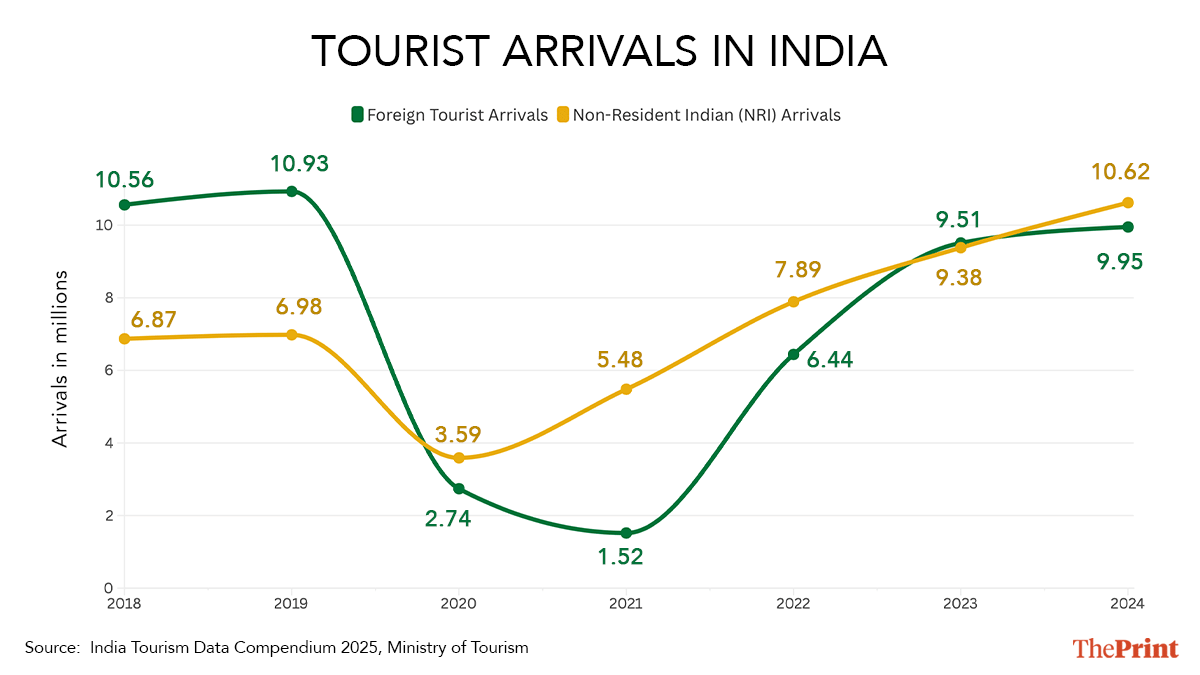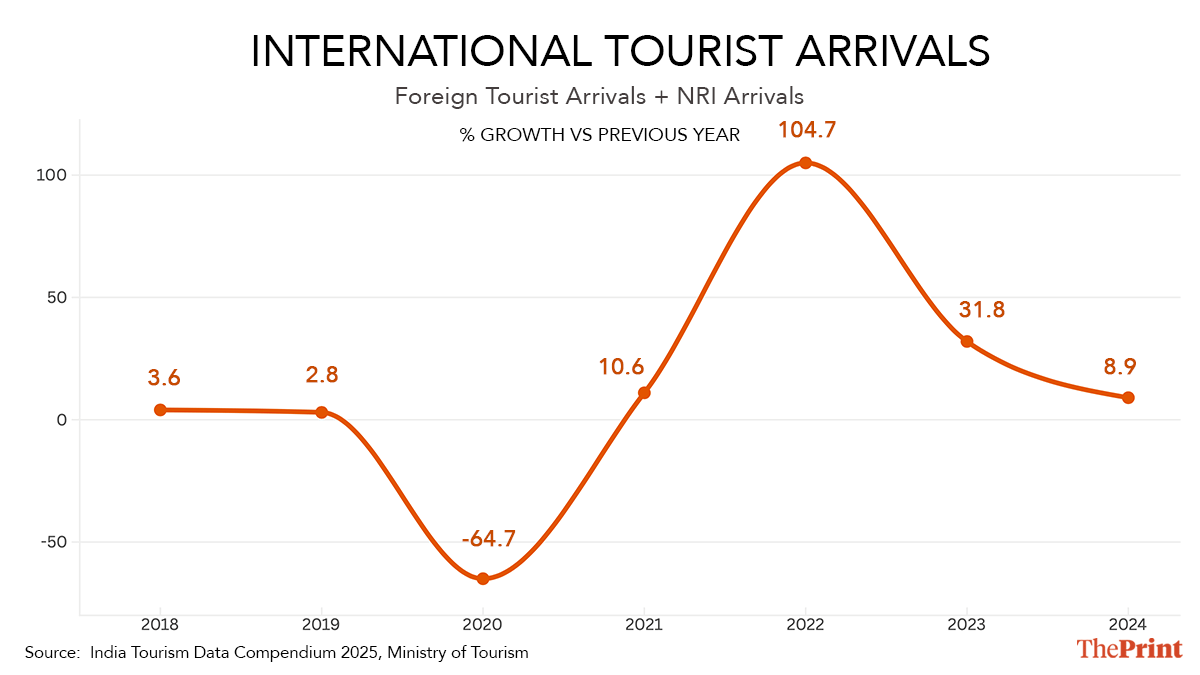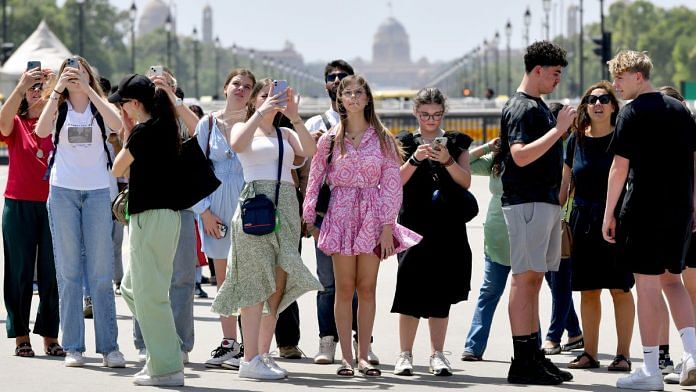New Delhi: Foreign tourist arrivals in India have grown at a slower pace in 2024, and are yet to reach pre-pandemic (2019) levels, according to the India Tourism Data Compendium 2025 released by the Ministry of Tourism Monday.
Last year, foreign tourist arrivals (FTAs) grew at 4.52 percent to reach 9.95 million, as against 9.51 million in 2023, falling short of the pre-pandemic level of 10.93 million, the report shows. While the figure had dipped significantly during the pandemic years—2.74 million in 2020 and 1.52 million in 2021—it picked up in 2022 to reach 6.44 million, and gradually improved to reach 9.51 million in 2023.
However, compared to FTAs, arrivals of Non-Resident Indians (NRIs) have seen a big jump, surpassing even pre-pandemic levels. The total arrivals of NRIs in 2024 grew to 10.62 million, as against 6.98 million in 2019, the data shows.
The surge in NRIs coming to India has taken the overall international tourist arrivals in the country to 20.57 million in 2024, compared to 17.91 million in 2019—a hike of 14.82 percent. For context, FTAs and NRI arrivals together make up the combined measure of international tourist arrivals. The tourism ministry began reporting arrivals of NRIs separately 2014 onwards.
“This strong rebound highlights the growing confidence of the Indian diaspora in travelling to India post-pandemic,” notes the compendium, compiled using data sourced from a diverse group of stakeholders, such as the Bureau of Immigration, UN Tourism, Archaeological Survey of India, State and Union Territory administrations, and the Reserve Bank of India.

But according to tourism sector experts, compared to NRIs, it’s the foreign tourists coming to India who are the main spenders, and there is a need for the government to increase tourism related awareness targeting this group.
“There is a need to increase the arrivals of tourists that spend on hotels, restaurants and monuments. Many foreign nationals that we count as tourists are actually Indians having foreign passports,” Anil Kalsi, vice president of Travel Agents Federation of India, told ThePrint. “The government needs to spend on promotion and increase tourism related awareness in foreign countries, which has slowed down over the last few years after closing of overseas India Tourism offices in 2023.”
In terms of overall earnings, in 2024, India’s Foreign Exchange Earnings from tourism amounted to $35.016 billion, registering a growth of 8.78 percent over $32.189 billion in 2023. This, however, accounts for approximately 2.02 percent of global tourism receipts, the compendium further notes.

Also Read: Amid US H-1B visa furore, Germany promises ‘liberal & stable’ migration policies for Indians
Fewer arrivals from China & Bangladesh
According to the document, among the key reasons cited for slow growth in foreign tourist arrivals in India versus 2019 is the decline in arrivals from neighbouring countries of Bangladesh and China.
While FTAs from China declined by 88.6 percent from 2019 to reach 38,960 in 2024, those from Bangladesh—that had peaked in 2019 at 2.58 million—declined sharply in 2024 to reach 1.75 million. In fact, Bangladesh, which in 2023 was the biggest source country for foreign tourists to India, has become the second most popular one behind the United States.
“These declines are likely influenced by factors such as policy shifts, geopolitical tensions, travel restrictions, and a shift in outbound tourism preferences,” reads the report.
Rajeev Kale, president and country head of Holidays, MICE and Visa at Thomas Cook India, told ThePrint that India’s domestic leisure travel market has huge potential to drive sustainable growth in the tourism sector. “To unlock this potential, a strategic approach is needed—one that prioritises strengthening infrastructure & connectivity, enhancing digital integration and fostering collaborative public-private initiatives to promote emerging destinations beyond traditional hubs.”
He added, “Government policies focused on streamlined regulatory frameworks, incentives for regional development and targeted marketing campaigns will be crucial in creating a robust ecosystem that supports diversified, inclusive and experience-driven domestic tourism.”
Where are most number of foreign tourists coming from?
According to the report, the United States was the top source country for India with 1.8 million arrivals in 2024, accounting for 18.13 percent of total FTAs. This was followed by Bangladesh, with 1.75 million arrivals (17.59 percent).
The United Kingdom remained the third largest source country, with 1.02 million arrivals (10.28 percent), followed by Australia at 0.518 million arrivals (5.2 percent), and Canada at 0.476 million arrivals (4.79 percent). Other countries on the list are Malaysia, Sri Lanka, Germany, France and Singapore.
For foreign tourists, December (1.06 million arrivals in 2024) remains the most preferable month to travel to the country, supported by winter holiday travel demand, aligning with favourable weather and year-end festivities. Other high-traffic months are February (1.03 million), January (0.98 million) and November (0.97 million).
With a 45 percent share, the most popular purpose for foreign tourists coming to India is leisure, holiday and recreation, followed by 28.49 percent share of visits by Indian diaspora, and 10.52 percent share of business/work related travel.
According to the report, foreigners from different regions travel to India for different purposes. For instance, 57.15 percent of 2.3 million foreign visitors from North America arrive primarily to connect with the Indian diaspora, while 55.2 percent of 24.1 million foreign tourists from South Asia visit for leisure purposes.
Among foreign tourist arrivals in India, the number of female travellers steadily grew from 40.6 percent in 2011 to 43.14 percent in 2024. While male foreign tourists constituted the majority share with 56.85 percent in 2024, the gender gap has narrowed from 18.8 percentage points in 2011 to just 13.71 percentage points in 2024.
Strong recovery in outbound travel sector
Compared to slow growth of FTAs, India’s outbound travel sector has shown a strong recovery post pandemic. From 26.92 million departures in 2019, the figure dropped by 72.9 percent to 7.29 million in 2020 due to the Covid-19 pandemic.
However, there was a strong rebound as restrictions eased, with departures rising sharply to reach 27.88 million in 2023.
“In 2024, outbound travel from India continued its upward trajectory, recording 30.89 million departures, a growth of 10.79 percent over the previous year. This sustained recovery underscores the resilience of India’s outbound travel market, supported by rising consumer confidence, expanding aviation networks, and growing demand for international leisure and business travel,” the report reads.
The United Arab Emirates was the leading destination for Indian nationals, followed by Saudi Arabia, the United States, Thailand, Singapore, United Kingdom, Qatar, Canada, Kuwait, and Oman. Together, these 10 countries accounted for approximately 71.16 percent of all Indian nationals’ departures last year.
(Edited by Mannat Chugh)
Also Read: NITI Aayog policy blueprint for homestays pushes for uniform regulations amid domestic tourism boom







Poor, undeveloped, dirty, Socialist India can attract only this many foreign tourists. To attract more, India needs to become a developed country with clean streets, world class police and judiciary, minimal crime, negligible pollution, etc.
I don’t think you understand what socialist actually means. I’d suggest getting a dictionary.
Kindly explain how nations like Sri Lanka, Malaysia, Thailand, Indonesia etc are attracting international tourists. Are these developed nations?
It’s time we stopped trotting out excuses